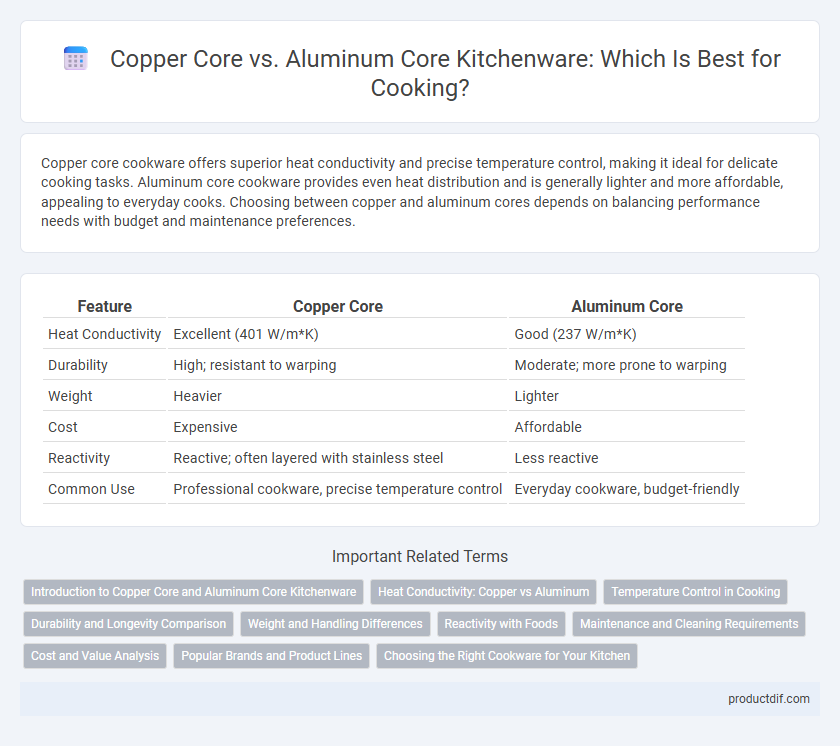Copper core cookware offers superior heat conductivity and precise temperature control, making it ideal for delicate cooking tasks. Aluminum core cookware provides even heat distribution and is generally lighter and more affordable, appealing to everyday cooks. Choosing between copper and aluminum cores depends on balancing performance needs with budget and maintenance preferences.
Table of Comparison
| Feature | Copper Core | Aluminum Core |
|---|---|---|
| Heat Conductivity | Excellent (401 W/m*K) | Good (237 W/m*K) |
| Durability | High; resistant to warping | Moderate; more prone to warping |
| Weight | Heavier | Lighter |
| Cost | Expensive | Affordable |
| Reactivity | Reactive; often layered with stainless steel | Less reactive |
| Common Use | Professional cookware, precise temperature control | Everyday cookware, budget-friendly |
Introduction to Copper Core and Aluminum Core Kitchenware
Copper core kitchenware offers superior heat conductivity and precise temperature control, making it ideal for professional cooking and delicate recipes. Aluminum core kitchenware provides efficient heat distribution with lightweight durability, commonly used for everyday cooking due to its affordability and resistance to corrosion. Both materials enhance cookware performance by optimizing heat transfer, yet copper excels in thermal responsiveness while aluminum balances cost and convenience.
Heat Conductivity: Copper vs Aluminum
Copper core cookware offers superior heat conductivity with a thermal conductivity rate of approximately 401 W/m*K, enabling rapid and even heat distribution essential for precise cooking. Aluminum cores provide good heat conduction at around 237 W/m*K, making them efficient but less responsive compared to copper. The higher thermal conductivity of copper ensures quicker temperature adjustments and consistent heat across the cooking surface, ideal for delicate culinary tasks.
Temperature Control in Cooking
Copper core cookware offers superior temperature control due to copper's excellent thermal conductivity, allowing for rapid and even heat distribution. Aluminum core pans provide good heat conduction as well but heat up and cool down more slowly compared to copper, resulting in less precise temperature adjustments. For recipes requiring quick temperature changes and consistent heat, copper core cookware is generally preferred for optimal cooking performance.
Durability and Longevity Comparison
Copper core cookware offers superior heat conductivity but is prone to tarnishing and requires careful maintenance to preserve its durability. Aluminum core cookware provides excellent corrosion resistance and lightweight strength, contributing to longer-lasting performance with less upkeep. In terms of longevity, aluminum core pans tend to withstand daily kitchen wear better, while copper cores excel with proper care but may show signs of aging faster.
Weight and Handling Differences
Copper core cookware offers superior heat conductivity but tends to be heavier, making handling more challenging during extended cooking sessions. Aluminum core pans are significantly lighter, enhancing maneuverability and reducing fatigue when tossing or flipping food. The weight difference affects user comfort, with aluminum core products favored for ease of handling, while copper cores provide premium thermal performance despite added heft.
Reactivity with Foods
Copper core cookware offers superior thermal conductivity but is highly reactive with acidic foods, which can lead to metallic tastes and potential discoloration. Aluminum core cookware also provides excellent heat distribution yet reacts less aggressively than copper, although it can still interact with acidic or alkaline ingredients if uncoated. Non-reactive materials or protective layers are often applied to both cores to prevent food reactivity and preserve flavor integrity.
Maintenance and Cleaning Requirements
Copper core cookware requires gentle cleaning with mild detergents and soft sponges to prevent scratching and preserve its polished finish. Aluminum core cookware is more resistant to corrosion and discoloration but should be cleaned promptly to avoid stains and retain heat conductivity. Both materials benefit from hand washing and drying immediately to maintain longevity and performance.
Cost and Value Analysis
Copper core cookware offers superior heat conductivity and durability but comes with a higher initial cost, making it a premium investment for serious cooks. Aluminum core pans provide excellent heat distribution at a more affordable price point, delivering strong value for budget-conscious buyers. The choice between copper and aluminum cores hinges on balancing upfront expense against long-term cooking performance and maintenance needs.
Popular Brands and Product Lines
Calphalon and All-Clad stand out as popular brands offering cookware with copper core technology, prized for superior heat conductivity and precise temperature control. In contrast, brands like T-fal and Cuisinart often feature aluminum core cookware, known for lightweight durability and rapid heating. Copper core lines, such as All-Clad Copper Core and Calphalon Tri-Ply Copper, cater to professional chefs, while aluminum core collections provide affordable and efficient options for everyday home cooking.
Choosing the Right Cookware for Your Kitchen
Copper core cookware offers superior thermal conductivity, ensuring even heat distribution and precise temperature control ideal for delicate sauces and rapid cooking. Aluminum core pans provide excellent heat retention at a lower cost, making them suitable for everyday use and versatile cooking tasks. Selecting the right cookware depends on balancing copper's performance benefits with aluminum's affordability and durability based on specific culinary needs.
Copper core vs Aluminum core Infographic

 productdif.com
productdif.com